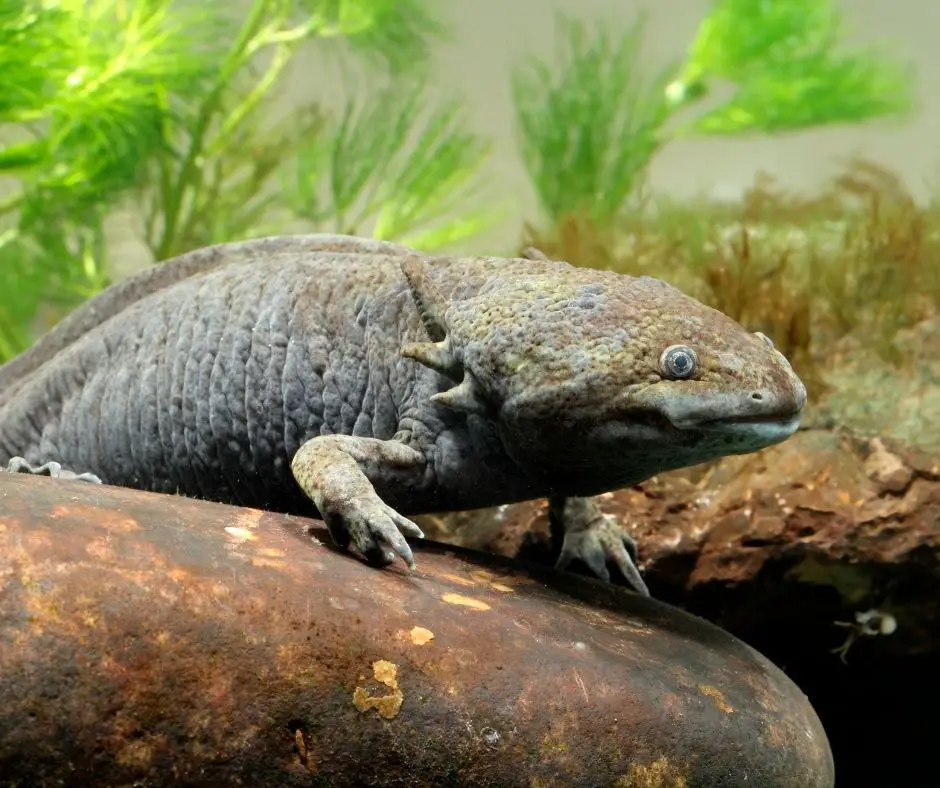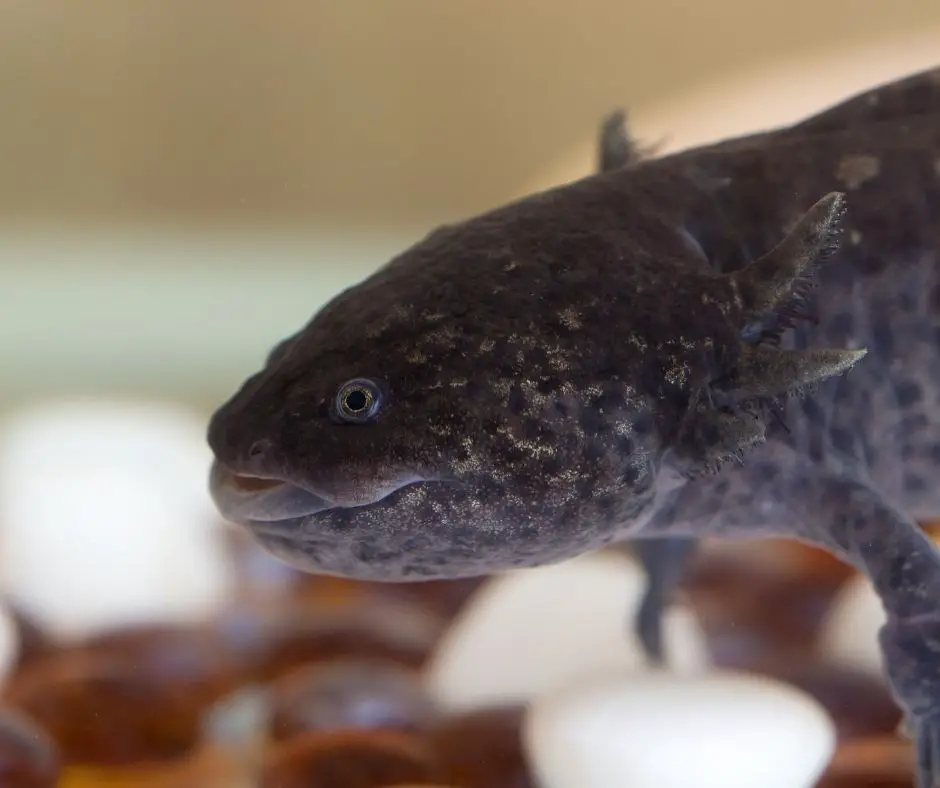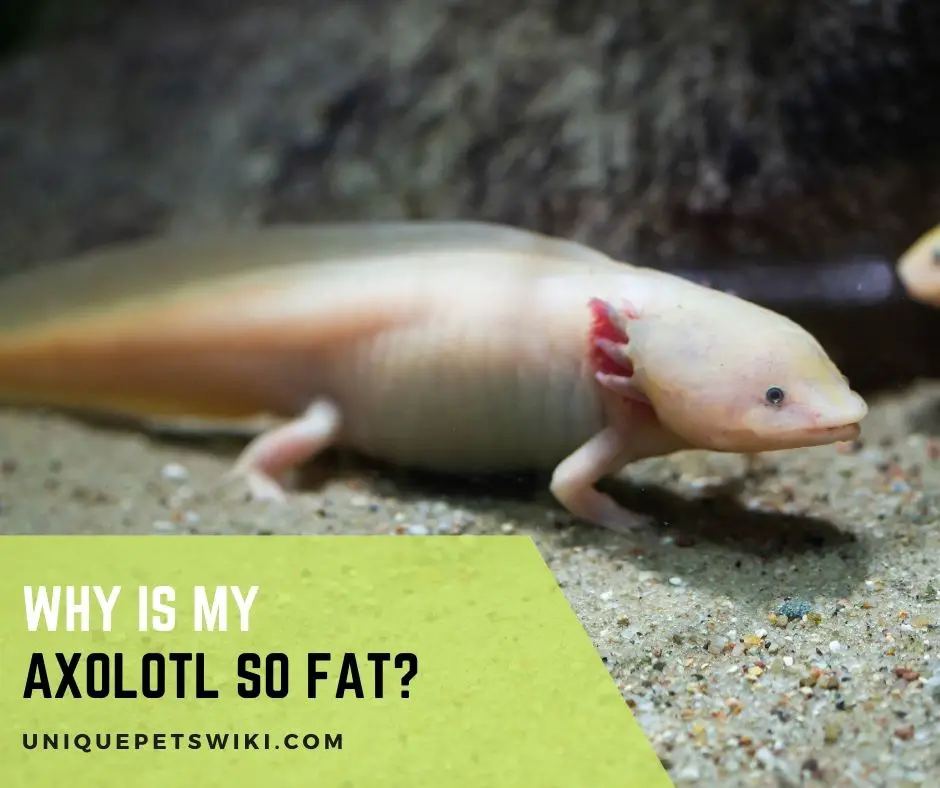Why Is My Axolotl So Fat? What could I be doing wrong? Ideally, a healthy axolotl has a rounded belly that is about the same size as its head.
Anything bigger or smaller than this is an indication that the axolotl is too fat (overweight) or too skinny (underweight).
Going by this description, your axolotls appearing so fat can be a result of three factors – overfeeding, feeding the wrong types of food, disease, or even pregnancy if it’s a female. Adult axolotls are supposed to be fed only 2 – 3 times a week.
Thus, when you feed them more than three times a week for a long period, they will become fat. Similarly, wrong feeding such as foods rich in fat – e.g. waxworms and butterworms can make your axolotls get so fat.
To understand in detail how your husbandry can affect the size of your axolotl, read this article to the end.
In the end, you’ll learn what you should do and what you shouldn’t do to keep your axie in health.
Contents
Can Axolotls Be Fat (Overweight)?
Yes, axolotls can be fat. Many axolotl owners have reported instances of their animals becoming fat. A healthy axolotl can grow to be 18 inches long and weigh anywhere from 100 to 250 grams.
However, they are not particularly wide creatures. A healthy axolotl will only have a belly that is about the same width/size as its head.
Therefore, if your axolotl weighs more than 300 grams, it is most likely overweight.
Similarly, if you have an axolotl with a stomach that is significantly larger than its head, you may have a very fat Axolotl.

Why Is My Axolotl So Fat?
The most common factor that makes axolotls get fat is overfeeding. However, many instances where owners think their axolotls are fat turn out to be other things such as a disease or even pregnancy in females.
Diseases such as bloating and impaction can cause swollen bellies in axolotls. A female axolotl that is heavy with eggs will also have a big belly and appear fat.
This makes understanding what size your axolotl should be at every age very important. This way, you can tell when your axolotl is getting abnormally fat and what to suspect.
That said, let’s delve into why your axolotl is so fat.
Overeating
Two things can cause overfeeding in axolotls – either you feed your axolotl too much food or you feed it the wrong kind of food, especially foods rich in fat.
Foods such as waxworms and butterworms are high in fat, hence, don’t make these foods their stable diet.
Overfeeding occur mostly in adult axolotls. Baby axolotls need food every day for growth. If they’re fed too much, they’ll vomit the excess food since they are incapable of storing excess food.
On the other hand, adult axolotls only need food 2 – 3 times a week. Therefore, when you overfeed them for a long time, they get fat.
Some adult axies will throw up food when they overeat, but some will not. If your adult axolotl throws up food once it’s overfed, you may not have obesity issues to deal with.
From your husbandry, specifically your feeding schedule, you can tell if you’re feeding your axie too much or not. Adult axies need food 2 – 3 times a week, so if you’re feeding yours more than 3 times a week, you are feeding it too much.
That said, what you should do to keep your axolotl’s size in check is to temporarily stop feeding it.
Also, reduce your feeding schedule to the normal 2 – 3 times a week. How often axolotls can eat in a week should not exceed three times.

Swollen Due to Disease
Sometimes what you think is fat can be a sign of a disease such as bloating. Axolotls can look swollen because of water or gas retention in the body.
This is a health issue often caused by kidney failure. Impaction can cause body or belly swelling too.
Younger axolotls that swallow too much air will also look swollen. Signs that your axolotl is sick with a swollen body are floating and loss of appetite.
Pregnant Female
This factor is gender-specific, which means that only female axolotls carry eggs. If you have a pair of adult axolotls in one tank, there’s a likelihood that your female will become gravid.
It’s very easy to tell if your adult female axolotl is pregnant – you’ll see the appearance of eggs in the belly and you’ll notice the gravid female swimming around quite often.
Another way to tell if your axolotl is gravid is to wait for about 24 hrs. and see if she’ll lay eggs.
Interestingly, female axolotls can carry eggs even when no male has fertilized them. However, this is rare.
What to Do if Your Axolotl So Fat
Excess weight can impact your axolotl’s health negatively. For this reason, you need to help your pet decrease its weight.
If you’re sure that your axolotl’s oversize body has nothing to do with disease or pregnancy, then you’ll have to reduce how much food you’re feeding it.
You may also have to get your axolotl to exercise a bit by making her work for food (that is dangle the food and make her swim up and down for a while to get it).
Axolotl Weight and Related Problems
- Axolotl underfed
In as much as overfeeding is bad as it leads to obesity, underfeeding too is bad as it leads to underweight. You can tell your axolotl is underweight or skinny if its underside appears really sucked in, instead of a rounded belly.
Often times you may notice other signs such as a shrinking tail and transparent ribs/ridges. Like obesity, underweight is more pronounced in adult axolotls than in babies.
To help your skinny axolotl get back in shape, check your water parameters and ensure it’s up to standard. Also, maintain a balance by following the ideal axolotl feeding schedule.
API FRESHWATER MASTER TEST KIT 800
- Contains one (1) API FRESHWATER MASTER TEST KIT 800-Test Freshwater Aquarium Water Master Test Kit, including 7 bottles of testing solutions, 1 color card and 4 glass tubes with cap
- Helps monitor water quality and prevent invisible water problems that can be harmful to fish and cause fish loss
- Accurately monitors 5 most vital water parameters levels in freshwater aquariums: pH, high range pH, ammonia, nitrite, nitrate
- Designed for use in freshwater aquariums only
- Use for weekly monitoring and when water or fish problems appear
Last update on 2022-12-30 / Affiliate links / Images from Amazon Product Advertising API
- Axolotl not eating
Several things can make an axolotl not to eat. These include sickness, poor water quality/environment, impaction or internal blockage, wrong size of food, or even wrong type of food.
Axolotls are not known to be picky eaters, but if your axie doesn’t like a particular food, it may not want to eat it. Anyway, this is very rare.
Also, if the axolotl is unable to poop, perhaps due to impaction or constipation, the axie will not have an appetite to eat more food.
Therefore, to avoid weight loss, you must evaluate your husbandry, find out why your axolotl is not eating, and correct the issue.
- Axolotl not growing
If your axolotl is eating but not growing, then it has more to do with its tank size and setup than its diet.
If you’re feeding your axie ideal foods rich in protein, minerals, vitamins, and calories, it should grow even if it’s at a slow pace.
But when your axolotl is not growing at all, it’s likely that your tank is small and your axie just stops growing to fit into the tank size, or your water quality is poor and that can hinder growth.
It could also be that your axolotl stops growing because it’s sick.
Conclusion
It’s normal to worry about the size/weight of your axolotl, especially when it comes with other symptoms such as inactivity, as the axolotl is too fat to move around as before.
But you should know that being overweight didn’t just happen overnight – it is a result of your care over time.
Feeding your axolotl foods rich in fat, feeding it too much, or even lack of exercise will result in it growing fat.
That said, earthworms, bloodworms, blackworms, and dendrobaena worms are what should make up your axolotls’ diet.
Keep in mind that your axolotl is healthy if it has a round belly that is roughly the same size as its head. Anything bigger or smaller than this is a problem you should address as soon as you can.
While you pay attention to your feeding schedule, it’s equally important you make the tank safe for your axolotl. Avoid using a substrate that could cause impaction if ingested.
Note that axolotls can become obese or appear chubby, yet they are still very active – swimming around the tank, pursuing moving things, and exploring their environment.
Their size becomes a thing of concern and of urgent action if they appear lethargic, float, or refuse to eat.

